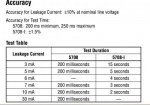ptonsparky
Tom
- Occupation
- EC - retired
Daughter is trying to sell her house. One of the gigs by a HI is that the GFCIs trip to slow. Home is 4 years old.
"All GFCI outlets when tested broke power too slow to meet current standards. Current standard is to break power within 25-30 milliseconds after being tested with a 7.5 milliamp load. All GFCI in the home broke at 115-164 or more milliseconds. Need to remove and replace existing GFCI outlets with new GFCI outlets"
Anyone have a reference for this requirement?
Personally I would ask to see his latest calibration documents, but other than that, is he FOS?
"All GFCI outlets when tested broke power too slow to meet current standards. Current standard is to break power within 25-30 milliseconds after being tested with a 7.5 milliamp load. All GFCI in the home broke at 115-164 or more milliseconds. Need to remove and replace existing GFCI outlets with new GFCI outlets"
Anyone have a reference for this requirement?
Personally I would ask to see his latest calibration documents, but other than that, is he FOS?


